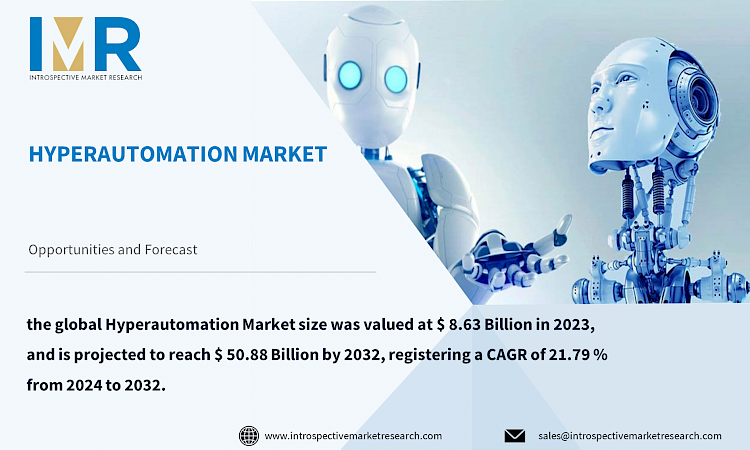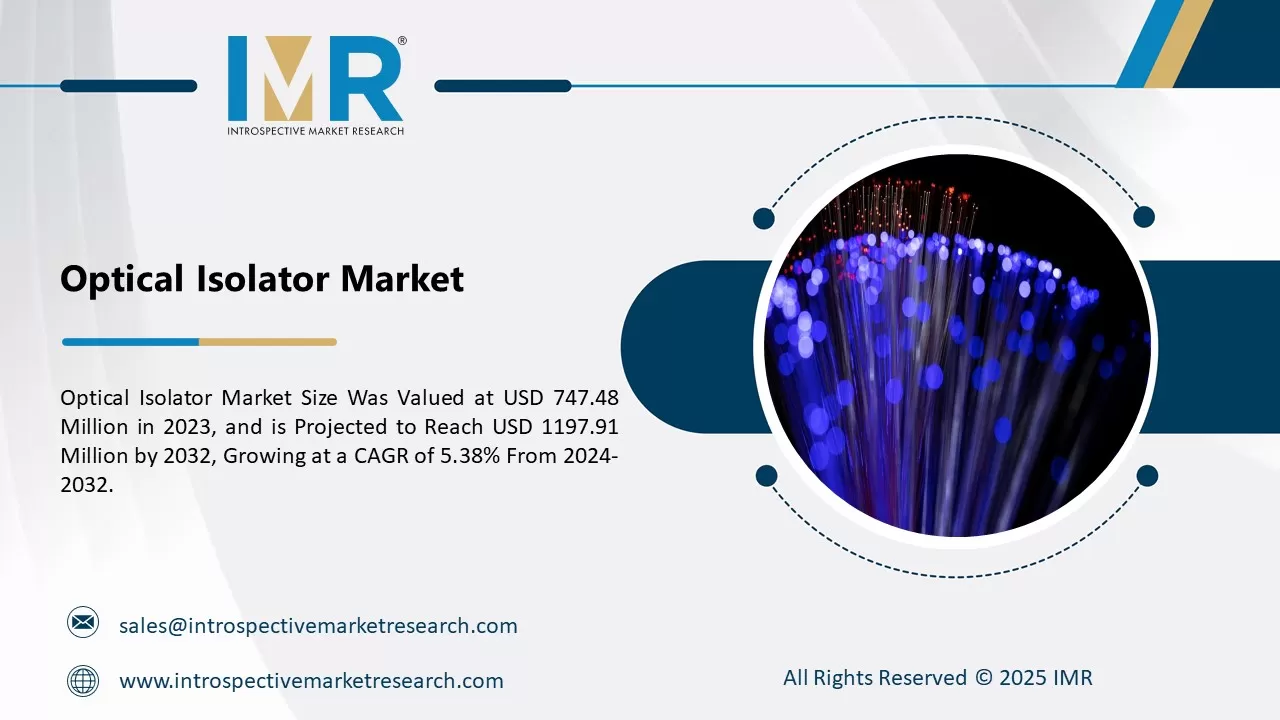
Market Overview:
According to a new report published by Introspective Market Research, titled, ?Hyperautomation Market by Enterprise Size (SMEs, Large Enterprise), Technology (Artificial Intelligence, Machine Learning, Robotic Process Automation, Others), End User (IT & Telecom, BFSI, Manufacturing, Retail, Automotive, Others) Global Market Analysis and Forecast, 2024-2032the global Hyperautomation Market size was valued at $ 8.63 Billion in 2023, and is projected to reach $ 50.88 Billion by 2032, registering a CAGR of 21.79 % from 2024 to 2032. Hyperautomation is a business-centric, disciplined approach that enables organizations to quickly identify, review, and automate as many business and IT processes as possible. Hyper-automation involves the systematic use of multiple technologies. Hyper-automation allows companies to quickly identify and automate as many processes as possible using technologies such as robotic process automation (RPA), low-code application platforms (LCAP), artificial intelligence (AI), and virtual assistants. Tools like RPA, LCAP, and AI are considered process-agnostic software that is easier to deploy across various IT and business applications in any organization. Process-agnostic software is most sought after as a highly automated trend enabler. The fastest-growing class of hyperautomated software includes tools to map business operations, automate and manage content processing, coordinate the work of multiple systems, and visualize the deployment of complex policy engines. The market is expected to grow at a double-digit rate until 2022. Other software designed to automate more specific tasks, such as ERP, supply chain, and CRM systems, is also growing significantly.
Hyper-automation promises complete automation of office tasks using various technologies such as robotic process automation (RPA), artificial intelligence (AI), and machine learning. However, the hyper-automation of the workplace is hindered by constantly changing processes, tools, and objectives, which require great flexibility and adaptation of office workers. Although business process management (BPM) techniques enable automation of the most common standard procedures, less visible and less standard but highly repetitive monotonous activities are still performed manually. A new strategy is needed to automate such processes, for example, less centralized and standardized, but still more adaptable, smarter, and more efficient. RPA with artificial intelligence is moving towards intelligent automation, resulting in a digital workforce - trainable intelligent digital assistants for specific functional jobs, not procedures.
Artificial intelligence and hyper-automation in legal technology have increased the productivity of the legal aid workforce, especially for in-house and contract law firms. Legal automation refers to the creation, implementation, and management of legal procedures, workflows, policies, and data mining based on predefined standards.
One of the largest industries focusing on automation trends in the financial sector. Companies in the financial sector are constantly looking for new ways to automate their business models and improve the efficiency of processes that usually require many people. Automation trends in FinTech leverage technological advances to create new opportunities for cost savings, increased efficiency, and productivity. Efficient processing of complex and demanding financial transactions requires the software to work very efficiently. The software used to automate the ATM process requires the development of both hardware and software technologies. One such software is known as an intuitive approach, which greatly simplifies the automation of financial transactions for financial institutions to use artificial intelligence technology to automate financial institutions using artificial intelligence technology to automate financial transactions for financial institutions.
Global Hyperautomation Market, Segmentation
The Hyperautomation Market is segmented based on Technology, Application, End-user, and region.
By Technology:
The technology type segment is further classified into the Robotic Process Automation. The robotic Process Automation sub-segment accounted for the highest market share in 2023. Robotic Process Automation (RPA) is a technology that runs on a computer and works with almost any system. It helps companies to automate repetitive procedures and make them more productive for human work. This can save 25-50 percent of general and operating costs. Robots can improve the efficiency and cost-effectiveness of repetitive tasks. RPA focuses on areas where the risk of human error is high, making it reliable and efficient and helping to improve overall quality. Data quality and analysis improve with seamless and accurate information from multiple sources that improve business decision-making. Hence, RPA offers significant growth prospects during the forecast period. Artificial intelligence is also one of the branches of hyper-automation that is growing rapidly in business integration. Artificial intelligence is a fundamental catalyst for advanced process automation and human empowerment and engagement. The success of automation is highly dependent on an organization's existing IT architecture and business practices. Whether it's leveraging robotic process automation to bridge legacy and modern systems, or combining hyper-automation with multiple combinations of machine learning, packaged software, and automation tools to get the job done.
By Application:
large enterprise segment dominates the Hyperautomation market. Large companies are prone to such new technologies because of the huge operations and huge data that must be optimally organized to increase the efficiency of the company. Large manufacturing companies, banks and financial institutions and companies, and giant e-commerce platforms require high automation of inventory management, documentation, and invoicing from internal and external sources, as well as repetitive data filing and reporting, which reduces the efficiency of the company. . . The integration of business process management and robotic process automation increased productivity by 30-35% in general operations, which can predict the highest profitability of such software. Therefore, large enterprises show a high opportunity for hyper-automated growth during the forecast period.
Region:
North America, particularly the US, dominates the hyper-automation market and offers a fertile technology landscape for companies developing and integrating hyper-automation solutions. Incumbents such as Automation Anywhere Inc., UiPath, and Appian Corp., as well as local catalysts such as Local Catalyst Inc., are driving growth in the region. The US market stands out as one of the largest and fastest-growing markets in the world, with a propensity for rapid technology adoption.
The hyper-automation market in Europe is growing rapidly, driven by demand for efficiency, cost reduction, and improved pricing. prevalence of digitization. European companies are embracing hyper-automation to strengthen their supply chains. Among sectors, Germany, Italy, France, and the United Kingdom are leading the adoption.
The Asia-Pacific region offers significant opportunities for the growth of hyper-automation, especially in the manufacturing sector. Countries with strong supply chains such as China, India, Cambodia, and Vietnam are increasing production. In particular, China is a global leader in the textile and chemical industries. Early adoption of automation in India and China positions them as key drivers of hyper-automation growth in the region.
Some of The Leading/Active Market Players Are-
- UiPath (U.S.)
- Catalytic Inc. (U.S.)
- Appian (U.S.)
- OneGlobe LLC (U.S.)
- Automation Anywhere Inc (U.S.)
- IBM (U.S.)
- Oracle (U.S.)
- SolveXia (Australia)
- Mitsubishi Electric Corporation (Japan)
- Allerin Tech Pvt. Ltd. (India)
- Wipro Limited (India)
- Tata Consultancy Services Ltd. (India)
- Vuram Technologies (India)
- JK Tech (India)
- and Other Active Players.
Key Industry Developments
- In July 2023, India's only integrated accounts payable and supply chain finance platform today announced the expansion of its product portfolio with the launch of its flagship Pay & Payables (AP) automation and payment product suite. Designed to revolutionize corporate financial operations, this suite uses artificial intelligence (AI) to automate complex tasks such as invoicing and payment processes, approval workflows, and real-time GST checks, enabling businesses across industries to achieve unprecedented levels of excellence.
- In May 2023, Wipro Limited (NYSE: WIT, BSE: 507685, NSE: WIPRO), a leading technology services and consulting company, today announced a five-year business partnership with ServiceNow (NYSE: NOW) to invest in and launch new offerings that empower customers. transform businesses, win business challenges, and deliver greater value. The agreement expands the two companies' existing partnership and is expected to accelerate Wipro's goal of building a billion-dollar business with ServiceNow by the end of 2026.
Key Findings of the Study
- Large enterprises dominate the hyper-automation market because they need to optimize operations, effectively manage massive amounts of data, and improve overall productivity with integrated BPM and RPA solutions.
- North America, especially the US, is emerging as a dominant force. in the hyperautomation market, driven by a strong technology ecosystem and established players such as Automation Anywhere Inc. and UiPath.
- Robotic Process Automation (RPA) leads the technology segment, delivering significant savings and efficiency improvements through the automation of repetitive processes. in performing tasks and minimizing the risk of human error.




